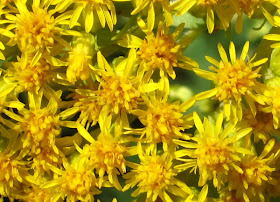While it may look like a member of the thistle family, the
Common Teasel (Dipsacus fullonum) is not a thistle. This member of the teasel family (
Dipsacaceae) is native to Eurasia and North Africa.

The flowers bloom on the egg shaped head in rows starting near the middle. The head is covered
with hundreds of individual flowers that
burst forth from between the bristles of the head. The color of the flowers can vary from pink to blue but the teasel on our cabin property has white flowers.

On the neighbor's property, the teasels are a blueish-pink.

This plant can grow in poor/dry soil and reach 9 foot tall. Our teasels are growing next to a rock pile by Joyce Road and are at least 8 feet tall.

Even a year after blooming the plant stalk and flower heads are still around.




















































